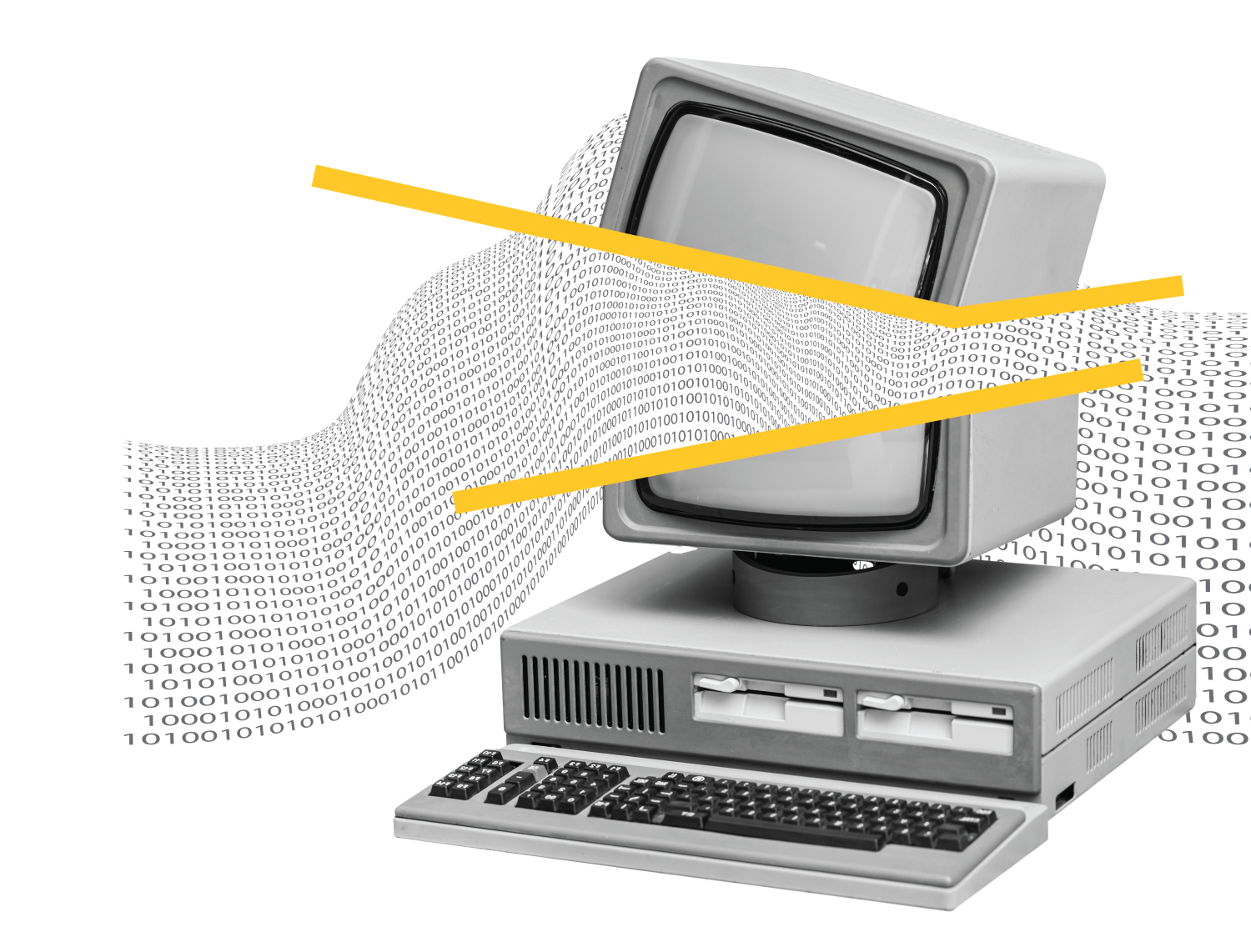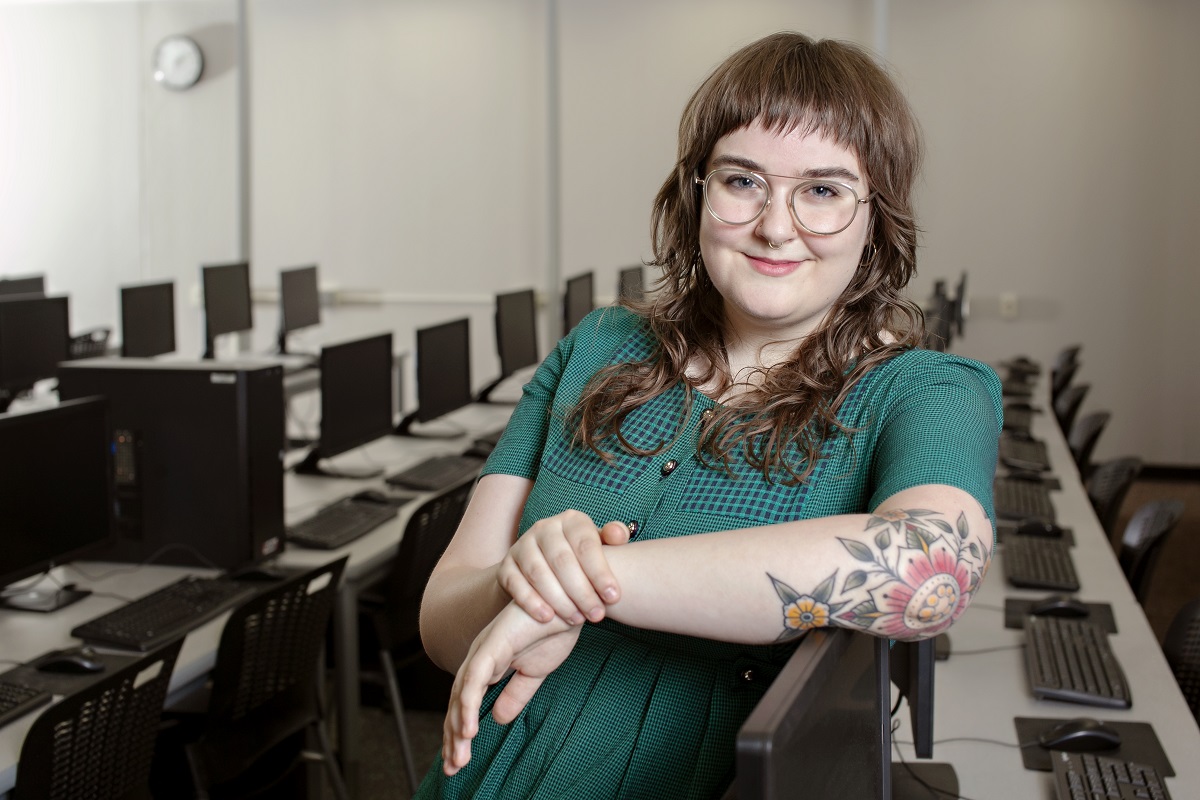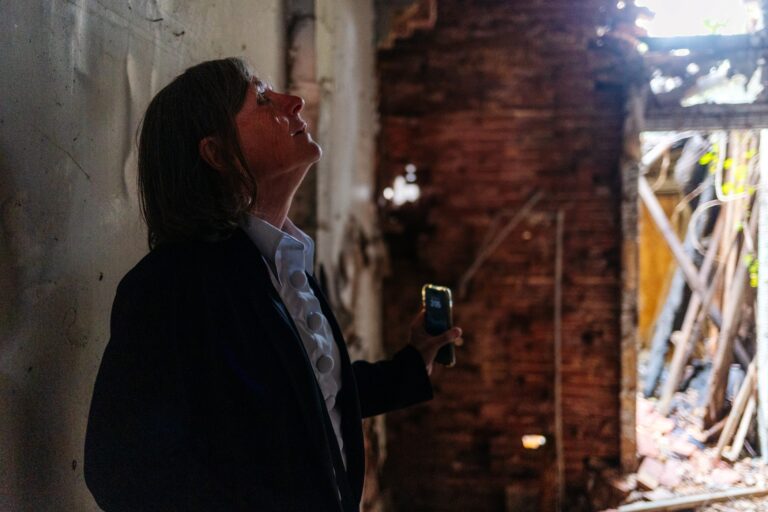Architect Kathleen Lechleiter ’81, ’82 is shaping safe, stable, and dignified housing in Baltimore neighborhoods.
Read MoreNDSU Computer Science Levels Up
Building new worlds in video games, predicting environmental disasters, and preventing cyberattacks — 50 years after its inception, NDSU's computer science program is more innovative and in demand than ever.
<story> by Emily Erickson '15 | Photo by Ann Arbor Miller | August 28, 2023

On a Saturday afternoon in the Quentin Burdick Building, NDSU students populate computer labs, focused on their glowing computer screens. It is quiet aside from typing, clicking, and the occasional whisper.
To a passerby, this is nothing more than a group of productive students. To the focused coders in question, this is a high-intensity annual tournament — the Byte-le Royale — and the rest of the day will be filled with stress, strategy, and fun.
One of the competitors is NDSU student Grace De Genaro ’25. Originally from Lakeville, Minnesota, Grace is a junior in the computer science program and a member of the Association for Computing Machinery (ACM).
In the Byte-le Royale, Grace and her teammates have been tasked with writing artificial intelligence using Python API (a high-level programming language) to program a bot to “play” the video game designed by ACM developers — in under 12 hours. There are action options, opportunities for points, and things that can go wrong. After a day of coding, algorithms, and good old-fashioned trial and error, a cash prize is awarded to the highest scoring team.
Activities like the Byte-le Royale provide students like Grace opportunities to get their proverbial hands dirty and see tangible results from what they learn in their computer science classes. Hands-on educational experiences are essential for today’s computer science students — some of the most relevant issues of the day may not have made it to textbooks yet. They also sharpen foundational skills for an education and career in computer science.
“I’ve learned to work under pressure,” Grace said. “Working fast and efficiently is important, but you also can’t let setbacks in your code affect you too much. Just take it in stride and learn from your mistakes. Everyone encounters bugs.”

For Grace, going into computer science at NDSU meant having the freedom to integrate her skills and passions and align them with her personal values.
“I’m a very creative person. I wanted a career where I could expand on that creativity,” Grace said. “I would really like to do something working with environmental preservation. Technology unfortunately has a very big impact on the environment; everything consumes energy. I would like to give back everything I might be taking away.”
To reach her goals, Grace hopes to find a career in data science or data analytics, fields that combine math and statistics, specialized programming, advanced analytics, AI, and machine learning with specific subject matter expertise to uncover actionable insights hidden in an organization’s data, as defined by IBM.
Data scientists can apply environmental monitoring, predictive modeling, conservation planning, and other methods of using data to address environmental issues. Grace provided an example of tracking air quality and pollution. Someone experienced in gathering data and running simulations could help predict what actions may need to be taken in the future to prevent environmental disasters.
To find someone with a research background in data science, Grace doesn’t need to go far — down the hall from her office as the student IT communications specialist in the Quentin Burdick Building, she will find the office of ACM faculty advisor and James A. Meier Junior Professor Anne Denton. Anne’s professorship was funded through an endowment established by James A. Meier ’59, ’71, ’07. James’ investment has provided research funding for many NDSU faculty members.
In Anne’s teaching and research, she prioritizes hands-on learning and what she calls “practical relevance.” Most of her courses incorporate an open-ended project — for which students propose the objective and concept — allowing them to apply the skills they learn in the course in a practical context. It also rewards their creativity.
Anne’s data science research focuses on agriculture — specifically, remotely sensed data using drones, airplanes, satellites, and sometimes hand-held sensors.
Satellites have been used since the 1970s in agriculture to determine the difference between near-infrared and visible light that tells farmers which parts of the field have good, healthy plant growth and which ones do not. This concept is known as the normalized difference vegetation index (NDVI). The NDVI can help farmers identify areas that may be stressed or experiencing nutrient deficiencies, optimize irrigation and fertilization practices, or monitor growth and development of crops over time to estimate yields.
For the last 50 years, these satellites have captured imagery at 100 feet by 100 feet. With new technological advances, satellites can capture imagery at much smaller fractions — 10 feet by 10 feet, 1 foot by 1 foot, or even smaller than that — meaning scientists and farmers can access additional information. For Anne, that prompts the question: How does that change the objective and implementation of algorithms that can be used?
Anne’s research group has developed algorithms for extracting complex properties for every point in an image. In comparable processing time, the algorithms make use of thousands of neighboring points for each image point, where existing approaches rarely use more than eight immediate neighbors.
Anne’s research and teaching also address some of the prominent topics of the day: ethics and AI.
“The ethics of artificial intelligence and machine learning has just in recent years seen a massive increase,” Anne said. In her class Artificial Intelligence, Ethics, and the Environment, students focus on geospatial AI applications and their ethical implications.
Today’s faculty, students, and researchers are actively preparing to address practical and ethical concerns in the computer science field and beyond. For example, Jeremy Straub, an associate professor of computer science at NDSU, looks for solutions to national technical and regulatory challenges and also considers their impacts within North Dakota.
Jeremy is the director of the NDSU Institute for Cyber Security Education and Research and a 2023-2024 senior faculty fellow at the Sheila and Robert Challey Institute for Global Innovation and Growth, an interdisciplinary research institute with the goal of advancing understanding in the areas of innovation, trade, institutions, and human potential to identify policies and solutions for the betterment of society. Founded thanks to philanthropic gifts, the Challey Institute was launched in 2019 and named in honor of Sheila ’23 and Bob ’67, ’09 Challey, who provided the leadership gift to establish the Institute.
One of Jeremy’s primary research and teaching focuses is cybersecurity, a subject that would benefit everyone to have some knowledge about.
“We all interact with technology every day,” Jeremy said. “We need to know how it works. We need to make sure it’s secure.” He develops AI techniques in his research with a focus on their application to cybersecurity.
“It turns out that the artificial intelligence that’s used to command a robot and the artificial intelligence that you can use to detect or prevent a cyberattack or take a corrective action are very similar,” Jeremy said.
His intention is to look at national and international issues and ideas — such as autonomous vehicle licensing and technology regulation — to both solve the larger challenges and to ask what they mean to North Dakota.
Jeremy believes that NDSU has the opportunity to be the lead university in the region in terms of cutting-edge research and education, which is why he has focused his philanthropic giving on the cybersecurity program. Philanthropic support enables research throughout the University — from the James A. Meier professorships to Jeremy’s faculty fellowship through the Challey Institute. He sees philanthropic giving as a chance to create an outsized impact and support the next generation of professionals.
“It’s about generating people that can solve these cybersecurity challenges of tomorrow,” Jeremy said. “There’s just so many things that we can do to enrich the environment — not only have good classes, but to also have a really good student experience both for the on-campus and the distance students.”
Just as technology transforms, NDSU’s computer science department evolves to keep pace with advancements. In the fall of 2019, the department moved from the College of Science and Mathematics to the College of Engineering. New specialized certificates have become available to students as needs have arisen, and in the fall of 2023, NDSU will offer a brand-new major: a Bachelor of Science in cybersecurity.
The new degree aligns with NDSU’s proposed strategic investment areas, which include cybersecurity, data science, and information technology, along with 14 others. The proposed strategic investments are part of NDSU Transform — an effort initiated in 2022 to “transform the University to meet future workforce and research challenges facing North Dakota and beyond, positioning NDSU for future success.”

After NDSU Transform, the creation of the cybersecurity degree, and research in AI, the department’s capabilities and priorities may be unrecognizable to NDSU’s computer science pioneers in the 1970s.
For example, in 1972, the year before computer science was offered at NDSU and two years before the inception of NDSU’s ACM, game developers at Atari released Pong, the legendary table tennis-inspired arcade classic. A half-century in the future, students at the University sit at their personal computers developing bots to play video games in the span of 12 hours.
Between then and now, one thing remains consistent: a spirit of innovation and the excitement of discovery. According to Grace: “[I]f you want to know something, there’s probably going to be someone in that room who can teach it to you and would love to teach it to you.”
</story>
Share This Story
Related Stories
Structures of Connection
Joanna Slominski ’04 wants us to think differently about construction — it’s more than bricks and concrete.
Read More
